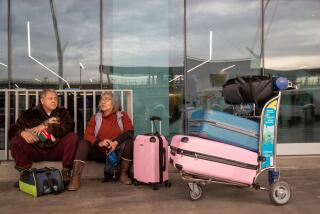Putting a face on the flight attendant furloughs puts the pain in perspective

- Share via
I’m a flight attendant for a legacy U.S. airline. Catastrophic revenue losses related to the COVID-19 pandemic led to the furlough Oct. 1 of 8,100 of my fellow flight attendants. On that day, $5.8 billion in payroll support from the Coronavirus Aid, Relief, and Economic Security (CARES) Act ran out.
In exchange for the payroll support signed into law March 27, the airline agreed not to furlough employees until Oct. 1. By that date airline and government officials believed coronavirus concerns would have diminished and passenger traffic would become more robust. But that has not occurred.
Unless Congress agrees on a second CARES Act, with additional provisions to aid the airline industry, the furloughs will not be mitigated. (As of yet, no relief bill has been passed)
Besides the flight attendant furloughs at my airline, some 1,600 pilots were laid off as were 2,225 employees from fleet service, 1,275 from passenger service and hundreds more from maintenance, dispatch and other work groups.
An additional 12,500 employees chose to take early retirement. Another 11,000 decided on extended leaves of absence. All told, our airline now has 40,000 fewer workers than before the pandemic.
The job losses are staggering, but behind the numbers are people. Real people. Some of whom you work with for only one day but nevertheless can’t forget.
At my airline, we’re assigned to work flights staffed by as few as three flight attendants and as many as 13, depending on the size and destination of the aircraft.
Sometimes I work with people I’ve known for years; occasionally, I work with strangers. But within our ranks strangers don’t remain that way for long. It’s not uncommon for two random coworkers to become BFFs by the end of the flight.
There’s an instantaneous camaraderie among cabin crew members, a palpable level of comfort that comes with wearing the same uniform and working for the same airline. Crew affinity is forged in cramped aircraft cabins during duty days that can drag on for up to 16 hours.
And when the plane lands in Kansas City or London or Saõ Paulo, Brazil, we rely on each other as tour guides, safety monitors and dinner companions because the crew is your out-of-town family.
I met a woman I’ll call Anna while working a flight from Fort Lauderdale, Fla., to Dallas. She exuded friendliness and greeted passengers as if they were guests in her own home. The woman was all smiles and happiness. When she said, “Good morning” and “Welcome” and “Have a wonderful flight,” it was as if she were belting out lyrics to a Disney song.
Shortly after completing the snack and beverage service, Anna and I retreated to the galley, sat on the jump seat and began to talk. She was surprisingly candid — even for a flight attendant. But her smile soon faded. Her song came to an end. Anna’s home life, I learned, was far from Disneyesque.
Anna was 27 when we flew together. She had been a flight attendant for five years and earned, at my best estimate, about $35,000 per year. She lived in a small one-bedroom apartment. If she had lived alone or with one or two roommates (as many flight attendants do and as I did at her age and older), making ends meet would not be terribly difficult. But Anna’s living arrangement proved problematic.
She shared the tiny apartment with three people: her boyfriend who had lost his job in the restaurant industry; a teenage brother with a drug problem and no prospects for employment; and her mother, who was battling cancer and relied on Anna’s company-issued medical insurance to help pay for chemotherapy.
Anna paid all out-of-pocket healthcare costs.
Anna paid for groceries so four household members could eat.
Anna paid for utilities and a cellphone family plan.
Anna paid the rent.
And now, because layoffs are determined on a reverse-seniority basis (last hired, first fired), Anna is one of 8,100 flight attendants furloughed by my airline. The one consolation is that furloughed flight attendants keep their healthcare benefits for two years. That’s a godsend for people such as Anna and her mother.
We can only hope the chemotherapy works, that Anna’s boyfriend finds gainful employment, her brother enters rehab and that Anna finds temporary work until the pandemic ends, passengers begin booking flights and furloughed employees are called back to work in the months and years to follow.
Until then, the news is less than uplifting because millions of Annas are out there.
More to Read
Sign up for The Wild
We’ll help you find the best places to hike, bike and run, as well as the perfect silent spots for meditation and yoga.
You may occasionally receive promotional content from the Los Angeles Times.






